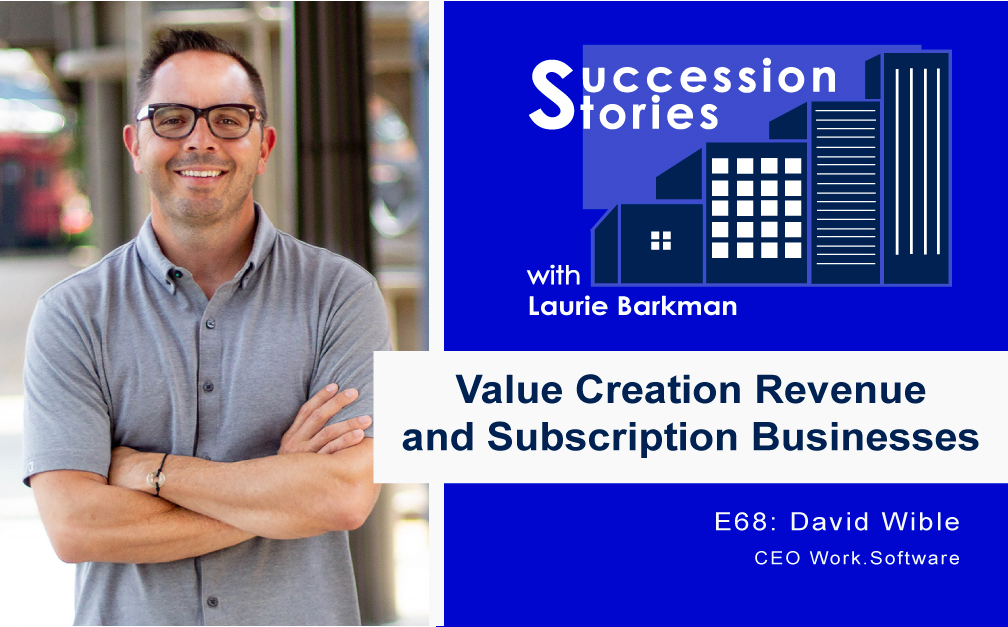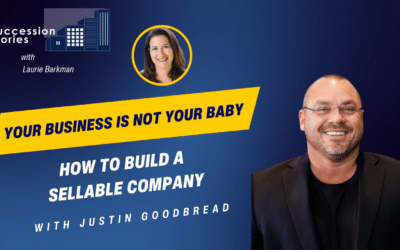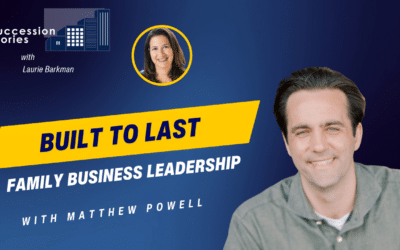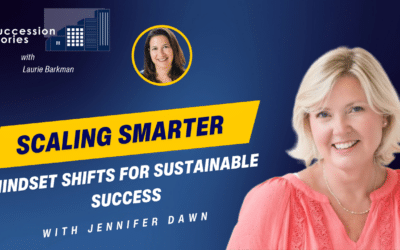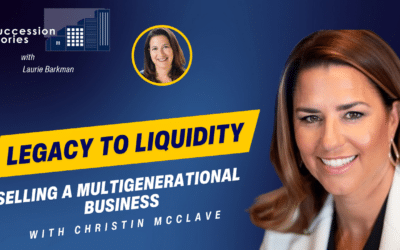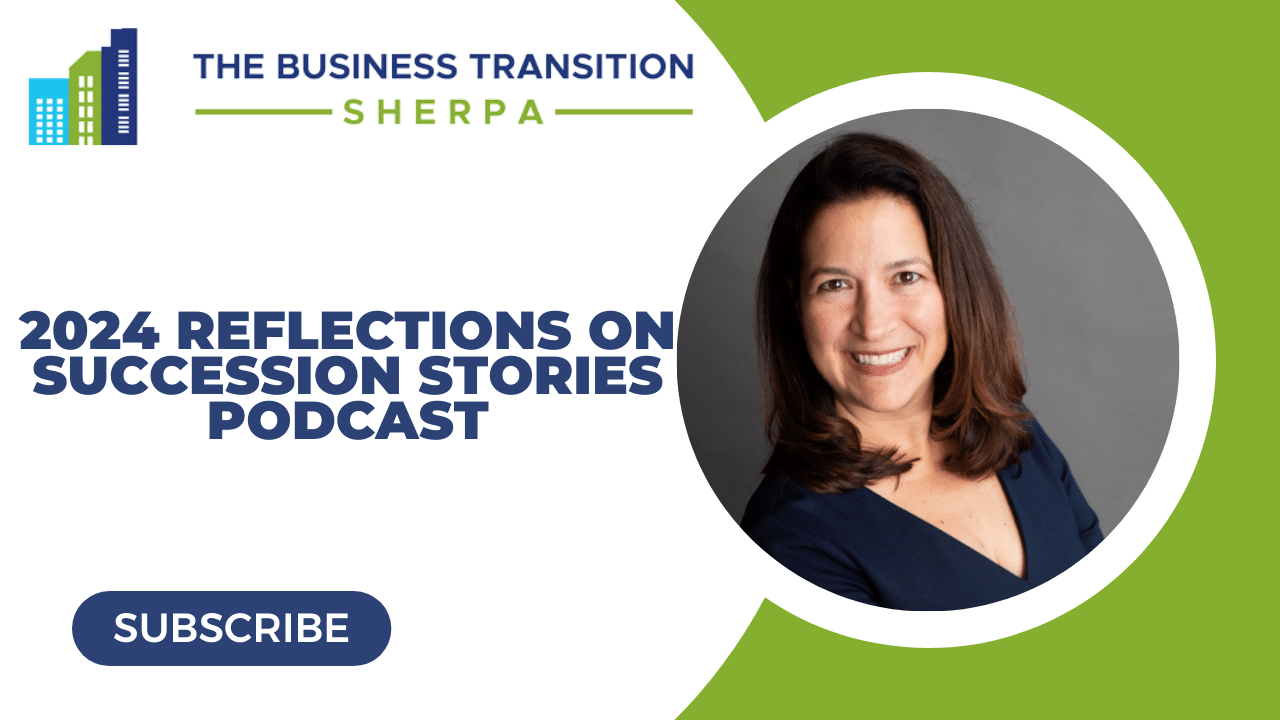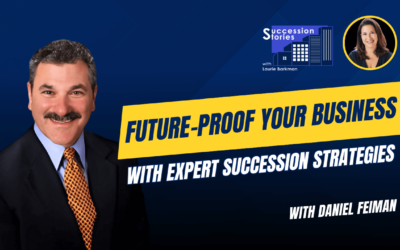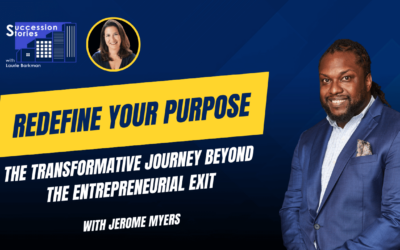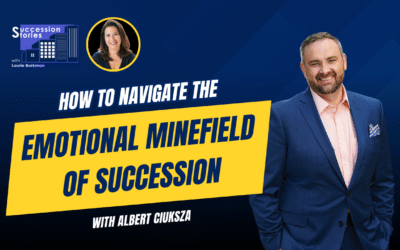Have you thought about who potential buyers of your company might be in the future? This week on Succession Stories, Laurie Barkman is joined by David Wible, CEO of Work.Software and former CEO of Industry Weapon, a company he sold in 2020. David shares his experience of selling his business, what made the sale successful, and why he started conversations five years prior to the actual sale. The key was understanding which value drivers mattered most.
Listen in to learn more about:
- The benefit of starting conversations with potential buyers before you’re ready to sell
- Viewing a sale from the buyer’s perspective
- How different kinds of businesses are valued differently
- Recurring revenue models
- Creating clarity across departments with the value creation revenue metric
Show Links:
Podcast website: SuccessionStories.com
Transcript:
Laurie Barkman:
David Wible is the CEO of Work.Software and former CEO of Industry Weapon — a company he sold in 2020. David shares some of the mistakes and things he would like to have done better. One of the coolest parts of his story, I think, was his occasional investment of time over five years talking with potential buyers. Why did he do that? To learn how his business was going to be valued and it paid off. They shifted one-time revenue into subscription revenue which David coined as “value creation revenue” because it was aimed to increase their multiple. If you’re thinking about selling your business, David shares some golden nuggets for what you need to take into account. Whether you’re going to sell in five months, or five years from now, listen in to figure out what you need to do today to get prepared.
Laurie Barkman:
David Wible, welcome to Succession Stories. This is gonna be a pretty fun ride, I think, talking to you not only about your enthusiasm for entrepreneurship and how you help entrepreneurs, but your story about your succession: creating and selling your company, so welcome.
David Wible:
Thank you so much. It’s great to be here, and I hope we meet the hype.
Laurie Barkman:
Let’s live up to that. Why don’t we start with your entrepreneurial journey? How did you come up with your first company, which is the idea behind the company called Industry Weapon?
David Wible:
Yeah, absolutely. It really wasn’t my first company, but it definitely was probably the one that I was with for the longest period of time. Interestingly enough, the name came out of just probably way too many beers and the idea that we wanted to provide a solution to business where we were one of those things in their quiver that they pulled out when they were running into trouble that helped them win the game of business.
Laurie Barkman:
Gotcha. Winning the game. Did you always know you wanted to be an entrepreneur? Were you wired that way?
David Wible:
I was. I had a father who was an entrepreneur, I always just loved every aspect of business. I think I was very fortunate in the fact that I was able to see a lot of different areas in business through my father. It was summers cutting grass, to then working on the shop floor rebuilding machinery, to nosing around accounting and purchasing and sales, so yeah, I always had the bug, and I really enjoyed the passion and enthusiasm that came from entrepreneurs, and I think I just caught the bug.
Laurie Barkman:
Tell me about Industry Weapon, what did the company do?
David Wible:
It was one of those really interesting opportunities. It helped non-technical people. So the marketing, merchandising, communication folks deploy their vision or their messaging on video walls, kiosks, and digital signs. Keep in mind, this is 2007, when we really started our journey, and so the big manufacturers were just starting to create devices at scale for this type of thing. So we partnered and were very lucky to partner with big companies like Cisco, Samsung, and LG, and all of those folks. But fundamentally, our focus was to demystify putting those messages on those devices.
Laurie Barkman:
I was in those shoes when I ran a marketing group and I recall learning about your company. I like how you positioned it, that it was technical for non technical people so you got to really understand who your customer was. How did you grow? What was the growth trajectory of the company from when you launched it to when you sold it?
David Wible:
We weren’t creative with the idea. We had a really great elevator pitch, my two partners and I, in how Industry Weapon was put together in the first place. We used to say that we helped create simple applications around complex technologies. Luckily for me, I was at an event and it had an opportunity where I bumped into somebody from Cisco and I was able to throw that elevator pitch at them, and they said, “Oh, my gosh, we just bought a company in this thing called digital signage. Would you be interested in taking a look, and that started our journey in the signage?” We were ecommerce guys, so drag and drop interfaces and things along those lines just came second nature, integrating with data was second nature to us and so we knew we had something very unique for that industry.
Then, very similar to how we innocently bumped into Cisco, I just looked at how these guys went to market selling their hardware and I found out that they used partners and so I just looked at all the partners that they had and picked up the phone and started calling and saying, “Hey, there’s this new emerging technology, and if you need someone to help you sell your hardware, all we want to do is is put this simple layer on top of it if the need arises,” and that’s how we got started. We just formed reseller relationships all over the world, and then broadened our offering to go outside of Cisco to every other manufacturer. So we tried to be operating system agnostic and endpoint agnostic. So again, a marketing and creative person doesn’t really care about all of that stuff. They just want to know, “How do I get this great message onto this screen?” So we tried to make it as seamless as possible for them to be able to do that without worrying about whether or not they chose Cisco, or Samsung, or whoever it may be.
Laurie Barkman:
So the reseller, not the reseller, the partner relationship was really important there in terms of your customer base. Were you also going direct to that end user, or was it your primary sales channel the way that the business grew?
David Wible:
Well, without doubt, the business grew through the reseller network and the channel. But just like every startup, the first idea needs to be the guy who’s creating the platform, or the idea needs to be close to the person who’s going to consume it and so we never really had a strategy to go direct. But those initial sales really were direct until we got our legs underneath us. It is also, I think, an activity of de-risking the partners. They wanted to make sure that we could have a home with their customer that would delight them, and then they would just take it from there and grow the business, and they absolutely did.
Laurie Barkman:
So was the relationship with Cisco exclusive for a period of time, or was it always meant to be that you were going to work with Cisco and other companies?
David Wible:
Naively, it was exclusive in my mind. It definitely wasn’t exclusive in their minds and so we never had any paper between us that said it was an exclusive relationship but we were a small team. So we had all we could handle with just the crumbs that they would throw at us. Once we got our legs underneath us, we recognized that it needed to be a bigger solution because in that space, in particular, no one manufacturer has devices that are going to meet the needs of those marketing people. Because as you know, being a creative yourself and having an agency, you have the vision, you don’t want to be told that it’s going to be hindered because of a hardware limitation, and so just out of necessity to serve the client, but also to preserve our well being we needed to go wide in regards to the partners we served.
Laurie Barkman:
So I love talking about deals and transactions, especially for entrepreneurs like yourself that built something, grew it and and then had an exit, had a transition that was that was successful, so I want to jump ahead to that and use the sale as a way to look back at what helped drive the value of the business, and why and how it became interesting to the buyer as a way for our listeners to understand what goes into not only building your business with a an exit in mind, which I think is your story that you and I had talked about off air, as a way for people to understand that background because it is not easy. This is a 10 plus year type of thing, this was not overnight, but I do want to talk about the sale, and again, then we’ll kind of look back. So tell me a little bit about the transaction, sharing what you can. I know there’s confidentiality and what you can and can’t share, but just a sense of scope, like where was the business, who bought it and so on?
David Wible:
I should first tell you that the relationship with the potential buyers happened very early on so it was about a half a decade before we decided to sell that I started having conversations with strategics, with growth equity, with private equity, with anybody and everybody who would talk to me investment bankers just to get a good sense of what the industry looked alike. I’ve got to tell you, that was so eye opening for me in regards to how my business was going to be valued, and what was a realistic expectation on the sell price.
I think a lot of times we were worried about even broaching that subject but if we don’t get clarity on it as the seller, you really hinder yourself in your ability to actually find the appropriate buyer and so having all those conversations really opened my eyes. I was a software as a service, probably before it was called software as a service so I learned from from those bankers that I originally talked to that there was going to be really two ways for me to sell the business, a multiple of EBITDA, which would be awful, or a multiple of revenue, which would be amazing. Then it really became clear that – and I coined the phrase value creation revenue or VCR – it came from those conversations and realizing that some of the revenue streams that I had that were creating great cash flow and profit to the business weren’t going to be calculated in in the sale of the business and so that really helped me get my my house in order in regards to what revenue I wanted my team to focus on and what I wanted to focus on and then most importantly, who the buyers were, that I wanted to go go after.
The conversations as I got closer and closer to the exit time, really started to take shape and create some clarity for me and then I also knew that we had taken a little bit of angel money, we all had some expectation of what the sale price was going to be. So it was really kind of simple for me to figure out, at what point would everybody be happy with an exit? Not necessarily, would we maybe be ready, but at what point and what did the business need to look like?
There’s two things working against you in that regard. One is you need to make sure you’re constantly having that upward momentum with the right revenue but also, I think, a piece that you realize that time isn’t on your side is, the speed at which you get to that revenue growth is also going to be calculated by the buyer. Luckily for us, right around January 2020, I think all those factors had already lined up, we were already doing dividends. But for me, I just stopped having fun. I think everybody should understand what their values are, and for me, what gets me up in the morning, gets me excited about any business that I’m a part of is it needs to require me to be resilient, challenged, and it has to be fun.
It just stopped being fun and so I knew we were already right from the metric standpoint, I was already okay, from my investors, they were happy to pull the trigger at any time, they were just awesome in regards to allowing me to do whatever I wanted to do when I wanted to do it and we were very fortunate because I had those conversations for a half a decade. We got our LOIs that were very comparable, three in particular, that were really great with three really great companies. Ultimately, we made the decision to go with the company that maybe wasn’t as attractive from a cash and pocket standpoint, but we felt like would be the best for our employees and that was really important to me, too. I wanted to make sure we picked the right company that could take it to the next level. I also wanted to step out so it also told me that a strategic made more sense than an investor because the investor probably wouldn’t let me step out. So having all of those factors made a lot of sense.
Laurie Barkman:
There’s so many golden nuggets and what you just talked about. I want to underscore a couple of them, the first one being something I love talking about with clients and advising them is to really take the time to look forward. If you are thinking about a transition for your business at some point in the future, which by the way, 100% of business owners are going to leave their company at some point in the future either voluntarily or involuntarily, why not be proactive? You did that. You took, as you said, about five years to get to know the industry, talking to strategics, talking to M&A firms or investment bankers and the really key point here is that the value of your company ultimately is in the eyes of the buyer. That’s what you did. You understood what factors go into how they look at that. That’s point number one, point number two being, how they were valuing your company was based on the type of company you were. So if someone’s listening, and they’re like, “Oh, I want a multiple of revenue,” well, not everybody’s company is going to be valued that way. So I think we should probably go back to why was it valued that way? It’s because you were 100% a recurring revenue business, correct?
David Wible:
Yeah, I should say, 100% of how the valuation was going to get calculated was on that subscription. Interestingly enough, having that conversation a half a decade prior, gave me the ability to look at some of the one time revenue streams we had and convert them into subscriptions. That’s the other nugget. You have all these really brilliant people who understand M&A that can be your Sherpa through this process, whether through a service they provide or just advice that they give and they’re there to share it with you and if you just keep your thinking cap on and your ears wide open, they give you the advice. For us, we moved about 15% of our one time professional services into a subscription, which benefited our customers, increase the amount of revenue that that stream actually was creating, because it was more palatable to the customer and ultimately, the revenue that was coming in now, all of a sudden, was playing a role in the exit price of the company, which, again, we would have never known that if we didn’t start having conversations with people who were experts in doing this.
Laurie Barkman:
Well, that’s an awesome commercial, and thank you for sharing that, because there’s a lot of people listening who probably are wondering how would they know these golden nuggets? You’re sharing from your experience in a variety of ways, and that’s certainly what I love to do; helping people find these aha moments and learning about these little – I won’t call it tricks of the trade – but what’s the playbook and if you don’t know what ocean you’re swimming in, it’s really it’s really hard to figure that out. So that led you to this concept of VCR as you say, which is this value creation revenue and so that’s how you were tying it together. You had this maybe one time revenue or occasional recurring as opposed to recurring and you couldn’t necessarily count on it. But a strategic or a financial buyer is gonna look at your revenues and profitability, they’re looking at how sure they are right about the future flows of that cash, so having a subscription model helps make that risk lower. It helps them understand that future value potential. Is that what you found?
David Wible:
I did. The other value that VCR value creation revenue metric has is it gives you the ability to communicate that metric whether people on your team are into finance and numbers or not. They can wrap their head around which revenue streams you find to be more valuable by coining it VCR and amazing things happen. For us, we were primarily a technology software company and my sales guys would get frustrated because they didn’t understand why I wasn’t excited about the hardware sale they just made but I was super excited about a lower sale that was made in subscriptions. Well, once VCR took hold, they then got it and then our technologists started looking at the most important revenue, and figuring out new ways to create features and functionality that created stickiness with the customer, so they didn’t leave us, and ways to reduce support tickets and enhance customers wanting to buy that VCR. It does so many different wonderful things for the business and I think the biggest thing is it creates clarity across all departments in a company on, “What we’re really going for, how do we all grow in the same direction if we all aren’t financially minded?” VCR really helps distill it down so we all can get why we’re going after the goal that we’re going after.
Laurie Barkman:
How did you message that? You talked about messaging in different ways, whether it’s to the technology team, to the sales team. Messaging is really important, because you can’t say it once and just think everybody has got it. How did you as a company, instill those key concepts, whether it was on metrics, like a VCR metric, or other things that the company, key leaders and everybody on their teams had that alignment? What did you find was really important there?
David Wible:
I can share a couple of things with you. One is I didn’t do it as well as I wanted to do it in Industry Weapon, which is why I’m doing some of the things that I’m doing now. I did a daily recording out to all of my employees for 12 years straight. I’ll never forget, because everybody always asked me, “How do you do it? What kind of technology do you use? And you know, how sophisticated is this?” Literally, Laurie, every morning I’d wake up, I would grab this thing called a cell phone. I would go to the recording app and I would say, “Good morning, everybody. This is – ” whatever day, “Monday,” I would I would say whatever was on my mind, and it was really important for me to tell them where we were going as a business, any roadblocks that we have in front of us if there was an elephant in the room that needed to be addressed. I would send it out to everybody via email and it was attached there.
My colleagues would say, you know, not all the employees are listening to that and I said, “At the end of the day, I really didn’t care.” I wanted them to but it also helped me doing things like this, trying to take a lot of the oohs and aahs out of my speech. Where I missed it is, I feel like everybody had really great clarity on our VCR, they had really great clarity on where we were going as a business but where I really fell down is I didn’t distill my vision for the company to each of their career trajectories or where they were going as an employee in my organization. Unfortunately, that starts to have the watercooler conversations that you’re a terrible communicator or something happens, they missed the message, because you haven’t been able to show them what that means to them. That’s probably one area I wish I would have done better at Industry Weapon, and we’re building tools to help leaders not make that mistake going forward at Work Software, which is one of the projects I’m working on now.
Laurie Barkman:
That’s good learning. As you would think about the business and what helped drive the value of the company, certainly it was the recurring revenue model that we just talked about. But there’s eight core drivers to what helps ultimately drive the value in the eyes of the acquirer. It could be things like culture, it can be things like how well organized your teams are, the processes; how well documented they are, it could be things like your sales process, that it was a flywheel, right that once it got in motion, that it became more and more productive. When you think about the valuation, and I know we can’t share what it is, but certainly as a multiple of revenue, we know that and it must have been a number that made you excited and then you felt good about. What were some of those other things that you can point to? Call it the structural capital, the operations, the culture. Are there any other factors where the strategic buyer said, “These are some of the reasons why we’re giving you a premium above your peers,” that they really valued.
David Wible:
I think without a doubt, it’s probably no different than when you find a great salesperson. You want to hold on to them. That great salesperson is someone you can build a budget around because the outcome that they say they’re going to hit is either met or it’s exceeded. My team in Industry Weapon was really good at that. One of the positives for having a company as long as we had is we could point to, “Hey, we never had a down month, we never had a down quarter, here’s positive cash flow, here’s profit.” You could really predict our growth and our success out as far as you wanted to go. I know that was really important to our acquirer that we were super super sticky with our customers so once you came into the organization, you really didn’t leave, and they really wanted to understand that because you’ve seen it before with different subscription based businesses. They do a great job of selling, but they did a terrible job of retention and I always say with any company, “Don’t show me first year success. Show me that the customer is consistently buying years 2,3 4 and beyond.” We had that in spades and they definitely wanted to understand it. We were global. We served a small customer. We had a bakery in Zanesville, Ohio, and then we were serving up global brands like Under Armour. It was an interesting business that, again, was predictable, but at the same time, had unbelievable potential. I think, ultimately, that’s what got their attention. Again, they were on me throughout those five years. That particular strategic was having consistent conversations, and we just weren’t ready. So we just kept pushing them off and thankfully kept eating their lunch enough that they were like, “Hey, let’s really get serious here and talk about bringing you into the company.”
Laurie Barkman:
So I know you had advisors, you had a law firm, you had an accounting firm, you had advisors like that, that you leaned on, as you were thinking about going to market and preparing for sale. As you reflect on your experience and selling the company directly – you didn’t have an intermediary involved – what do you think are some of the biggest lessons learned and what would you do differently?
David Wible:
Wow. Well, I can say first and foremost, I have the best team ever, so when it came to not having a banker, I didn’t have to have an investment banker because I had two partners in my company that were awesome, that gave me the room to be able to step out of the business and focus time without having the business go awry.
Laurie Barkman:
Did it take a lot of time?
David Wible:
678 requests later. It’s not even just the amount of hours on the transactions, it’s the amount of hours thinking about the transaction and all the stress that comes from every question, every request, “Do I have that document? Oh, my gosh, is this going to happen?” I signed the LSI a week before the pandemic and so immediately, I’m thinking, “I’m gonna get a haircut through this process,” and thankfully, we never did, because we had a great team in place to make sure the business wouldn’t fall down.
When it came to doing the deal, I had two rockstar investors on my board that sold their company for a bajillion dollars right ahead; Eric Cooper and Mike Green. It’s like, you have these unbelievable coaches that are more like coaches than investors to me that had already told me their stories of acquiring companies and what to do and what not to do. So that helped me get prepared. Then on the transaction side, I had Eric Klein, who was phenomenal, Mr. M&A and legal that was my psychiatrist as much as my lawyer and then I had two amazing accounting teams that were acting as my CFO, both Mark Mooney and Jeff Kofax. So I had the deck stacked for me, because I had that team and that really helped.
Now, where I would have done things a lot different is, I knew the superpowers of our team, and they were incredible. I wish we would have done a better job at documenting and highlighting each employee’s superpower because unfortunately, the buyer was much bigger and they didn’t have quite the view into some of these amazing people that I did and they made some dumb decisions in my opinion, because they weren’t able to see what we already knew. That’s one of the things that I’m working on with one of our new projects at Work Software to make certain that those awesome employees that sometimes are a little more passive from a personality standpoint, don’t fall through the cracks and don’t either leave the organization or get let go from the organization because someone doesn’t see it.
Laurie Barkman:
That’s a good segue. Let’s talk about what’s coming next, because you are an entrepreneur through and through. You had jumped into your next project, as you call it, which is Work Software, and that’s how we got connected because, I think Eric made that connection for us in terms of what I do, and working with companies to help them create value and transition when they’re ready to the to their next venture or to sell, whether it’s buying a company or selling a company. For you going through your experience and now with Work Software, it just was a really good fit and so our firms are partnered, and I’m excited to be able to offer this service and product to my clients. Because for all the reasons we’re going to talk about, like how does this platform help a company scale effectively, and do the things that you talked about, where if you had the ability to jump back in time, you would have done some of those things. Let’s jump into that. What’s the mission of the business?
David Wible:
Well, the mission of the business is to improve employee performance and help consistent growth into a company. In dealing with companies you hit plateaus at certain levels, whether companies fall off this certain revenue level, or they just taper off. It’s getting to a million, it’s getting to 5 million then 10, then 25, and then beyond. What I found interesting with our organization is we started to use a methodology that I ended up coining the action based framework, and it was utilizing the ability to see the things that were going on into the organization and making changes in the organization prior to the next monthly financials coming out. So I said we were always cash flow positive, profitable and debt free, and it was because we can make these changes and so that works out where we formalized the action based framework and then we started to put tools in place for some of the things that we wished we would have done better at Industry Weapon to allow leaders to be able to grow their business, take that vision, and if they’re at that breaking point, be able to bust through it and take it up to the next level. There’s really just three components, and it’s really simple and it fits with this conversation. The first is, you need to understand how to play the game of business. There’s a very specific way you keep score, just like in football it’s field goals and touchdowns and safeties. In business, it’s cashflow, profit revenue and then eventually, of course, I’m not going to forget our VCR value creation revenue. We look at that quarterly, we use it as a way to gauge whether or not we’re winning at the game of business. So we always want to see those numbers increasing.
The next and probably the juiciest part of this is all around accountability. It’s the piece that I am most passionate about because I feel like I could have done a much better job of accountability, meaning the interest or the interaction or collision between the manager and the employee, not dismissing the annual evaluation that needs to happen where the employee and the manager fight over pay, but actually tabeling that and in utilizing a very simple process to every month, create some clarity and get some frequency between the manager and the employee talking. So we serve up a thing called a map. We want to know, “Hey, how do you rate the employee’s mindset ability performance? How does the employee rate themselves in that regard?” That’s doing nothing more, Laurie, than having a deeper conversation with the employees so that you don’t fly by the desk of the good performer and say, “Laurie, keep it up. Good job.” And Once that’s done, and we go over the delta between both our surveys, we then create what we call an individual impact plan. This is the piece that I’m probably most proud of, it’s allowing the employee to understand what is the one metric that they’re going to be measured by, and when they prioritize their day, they should put this at the top of their list. What are the actions that they can take to make that metric a success for them at the end of the month? This gives the manager a chance to be a coach. So if the manager got promoted and isn’t really sure how to be a manager, this helps them get into that coaching of showing them how to actually make a better month than the month prior.
Then the last piece – and it always stresses everybody out – is that plan has to be relevant to the business, it has to tie back to one of the goals. Just like in every sport, every position needs to actually contribute to whether we’re winning or losing in the game and so this is really important to make sure that that metric is helping us all win. The last piece is what I call a strategy and that is, “Hey, now we know how to keep score. Now we know the teammates and their strengths. What’s the playbook in each department? How do we make sure that when things change that we can change on a regular basis?” So Work Software helps create collaboration, a more streamlined way every week between the department leader and his or her managers, because we all know, the manager thinks that needs to be done this way, the employee is doing it this way but somewhere in between is probably the right way. So we leverage a collaboration strategy, and an application that walks you through weekly meetings so they’re not a snooze fest. They’re really helping employees be able to perform independently the next week, give the manager time back to manage and then hopefully see the department consistently growing up into the right. Then on top of it all, work has an intensity score that it gives to the employee, the department and then the overall company, allowing companies to be able to say when they’re not maybe performing exactly where they have an issue so they can prescribe the right solution.
I think that’s the really neat thing about this system is I’ve seen a ton of different management consulting technologies out there. But usually they’re an integration and another report to just say you suck, they don’t actually show you where you need to work. This thing does it and it does it in a very innocent and easy way for you to actually correct it. Again, it all comes down to just doing the work right. It’s all about grinding it out and not just from the bottom up but from the top down as well.
Laurie Barkman:
I think what’s really cool about the framework is that a lot of companies are pretty decent. Let’s say it’s setting strategy. I have clients that have no strategic plan, or they’ve thrown it out the window because of COVID and they’re hitting the reset button. I’m a big believer in having a plan because if you have no plan, then certainly you’re not gonna know where you’re headed, and you’re not going to get there. So if you have your plan, how do you gain that alignment? How do you go from, “Hey, here’s this lofty vision, and here’s this lofty mission and our objectives and our goals,” to actually executing? There’s some statistics out there that basically say 80% of the companies are not effective and implementing their strategies. So we fall down in the execution, that’s a problem. Your system takes it to that level to say, “Hey, here’s the cascading that needs to happen,” and that was my philosophy, too, when I was a CEO, and running a business. We set the direction with the strat plan but then we actually brought these things to life, operationalized them, and tried to get them to the level you are at. Could we have used your tool back then? Yeah, probably, to help with that. But I think that was one of the things that really, I found compelling about it.
I think as companies are looking to create enterprise value, it’s about the sustainability of the tools and the systems to help deliver the value to the client and then therefore getting that ROI on that effort. So congratulations to you on on that transition, because going from selling your company to then figuring out what’s your next thing and having this mountain climber mentality and I know you like to run and climb mountains, and that sort of that analogy works, it just clicks when I think about you, that you’ve jumped into your next thing, which is super cool. Again, I’m excited about our partnership there. As you think about then, as we want to start to wind down this conversation, some actionable things for business owners to think about, whether it’s from the reflection, from your experience on building and selling your company, or if it’s pertaining to how to be effective and implementing these goals and the mindset and getting the alignment. What are some of the takeaways you’d like to share?
David Wible:
It’s funny, I think, that question, although it sounds like it’s gonna require multiple answers, to me really only requires one in and that is, start having the conversations now. More often, I always say that simplicity isn’t about dumbing things down, it’s really just about two things and doing these two things on a regular basis, that is, frequently doing them, right. Have conversations with your employees, or strategics, or strategists frequently, and then clarity. Ask the questions to get clarity on what it is that you’re either going for, or that you’re not able to accomplish. At the end of the day, that is what drives everything forward.
I found, especially with employees, a lot of times we think they must just be lazy, or they’re just not going to do it. Well, sometimes it’s just that we either A talk too fast, or B, we haven’t said it enough. Everybody is my dreaded four letter word: busy and so sometimes they don’t hear you. So you’ve got to say that thing that you think only you need to say once, many times, probably somewhere in the neighborhood of 12 to 15 times and so frequency is key, then making sure that you have on your team, whether it’s the advisors or the employees, a team that’s not afraid to ask those clarifying questions like, “I don’t quite understand that, or let me repeat it back to you. I think I heard what you said.” It’s amazing to me, how just doing that simple act will move the ball tremendously forward. We often think because we know it everybody else knows it and I can tell you, the clients that I work with, and the clients that pass at times on not wanting to work with Work Software, it’s all because it’s that accountability. In the end, the grind is to actually communicate more regularly. That either turns them off or turns them on to success. Unfortunately, or fortunately, depending on your personality, that’s what’s required to move the business forward or get to an exit. You’ve got to talk to a lot of people and get clarity on what you’re hearing and saying.
Laurie Barkman:
Yeah, that’s a good point. Do you have a favorite saying? I know you have, I know you do, about lots of things. Is there something that helps give you a guiding light?
David Wible:
Absolutely. The quote is from Mike Tyson, which is, ‘everyone has a plan until they get punched in the face’ and I think it has 100% been one of the things that has driven me my whole life, I think. Early on, I had a lot of successes and then the way I started Industry Weapon is I got fired from a job and had nowhere to go, had two kids, had a mortgage, had all of that stuff and didn’t know what to do next. It was the best thing that ever happened to me, because I realized that I could get punched in the face, fall on the floor and stand up on my own two feet and march forward. I think every day, we have certain versions of that that happened to us. It doesn’t mean we stop planning, but it’s really good to know that you can grind it out when you need to.
Laurie Barkman:
That quote has come up before, so you’re not alone. It resonated, and I think a lot of us have experienced that shock to the system. It’s something you just didn’t expect and thematically, that’s why the show is around. We talk about the theme of change and transition, and sometimes it’s planned, and sometimes it’s not, and I love how you describe that. That’s what led you down the path for your entrepreneurial success. One of the things that you and I are doing is continuing to educate business owners on how to create value, whether it’s to have that successful sale in the future, or just to run a more effective business, and they could put their feet up on the desk, and have other things to do besides the day to day aspects of running the business. So we’ve got a webinar that we’re doing around that topic of value creation, and I know from the time of recording this I just want to mention that, because I’ll be sure to include a link to it in the show notes. I’m excited to be able to continue the conversation with you and in a more granular way for our listeners.
David Wible:
I agree, and what I love about it too, Laurie, is because we have the skill sets that we have, it’s like there’s tactical things that I think every leader needs to know, do and understand. But then there’s these strategic things, these softer things that end up coming up and I think one of the fun ones for me is understanding your values. Not the fluffy ones, not the ‘be a great dad, parent,’ whatever. But what is it that actually drives you? I think for every leader, it’s so important to understand when it’s time to exit a business. Sometimes it’s because, “Oh my gosh, the offer’s so good, I can’t pass it up.” But sometimes I’m ready to write the next chapter, and I need to understand why I’m ready to write the next chapter. What is missing that isn’t making me feel great? That’s what’s awesome about this Next series, is you get the tools on how to tactically go about it and then you have all of the strategies on the big why. Everyone says, “Come up with the big why, but they don’t tell you how to figure out the big why.”
Laurie Barkman:
It’s hard to figure out. It really is, and you can’t just sit down and write in 30 seconds. Maybe you can but then you put it away, and you come back to it and you erase and type over it and it’s really important. Whether it’s for you personally or for the business or that intersection, I agree. I think the exercise to really understand your values is so important. You go to a company even as big as Amazon, and I don’t know if you’ve ever been to an Amazon distribution center, I have and you go into one of their conference rooms, or you go to headquarters, and you look up and on the walls of the conference room there are 20 values, like 20. I mean, they have a lot, and they explain them and they repeat them as you were saying about messaging earlier, and so knowing who you are, knowing why that’s important, that helps give you that North Star and set that direction and making tough decisions based on your values, that’s kind of what life’s all about. If people want to connect with you, or find you online, David, what’s a great way to do that?
David Wible:
You know, I’m on LinkedIn. You can find me just by typing in David Wible, and then my email address is David@work.software. So not .com but .software. That’s the best place. They also obviously know you so they can reach out to you and you can connect them that way too so there’s a variety of ways.
Laurie Barkman:
Absolutely, well, this was really eye opening. You’re an entrepreneurs’ entrepreneur, you’re passionate about what you do, you bring a lot of value to companies that are looking to transition over time and be more successful, so thank you for being on the show and sharing what you’ve learned.
David Wible:
Thank you. It was a blast.

